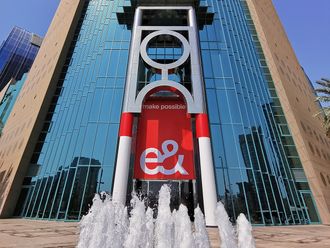Dubai: The Dubai Financial Market General Index (DFMGI) dropped by 51.53 or 1.61 per cent last week to close at 3,157.45. This was the third consecutive week of losses and the sixth week out of the past seven that the index has closed lower. Market breadth confirmed the bearish performance as there were nine advancing issues against 27 declining, while volume reached a five-week high.
The DFMGI took another beating, falling to a 25-month low, the lowest weekly closing price since late-February 2016. Although not discussed in recent weeks, the consolidation pattern that has formed over the past couple of years, following the January 2016 bottom, is that of a complex head and shoulders top. Last week’s fall confirms a breakdown of the pattern as the 3,195.49 support level was clearly broken, with the DFMGI closing at the low for the week (very weak close) and below that long-term support price level. Therefore, the head and shoulders consolidation pattern now takes on potentially greater importance.
Technically, the classic neckline (support line) identification was first broken five weeks ago. However, within the larger consolidation price structure there is a significant horizontal support zone around the 2016 low of 3,195.49. That price zone clearly acted as support on two separate occasions over a six-month period and therefore can be considered similar to a second neckline. Now that it’s clearly busted there is greater confidence that a bearish trigger of the pattern has been confirmed. Whether the follow-through is as bearish as it might be, remains to be seen.
A head and shoulders top consolidation pattern is a classic trend reversal pattern in technical analysis and the pattern can be used to calculate a potential minimum target once a breakout is triggered. We can take the height of the pattern in price and subtract it from the neckline (trend line support across the lower portion of the pattern) in order to arrive at a potential minimum downside target.
If the first and higher neckline is used for the DFMGI then the target is approximately 2,843.70, while a target around 2,671.3 is estimated when using the lower neckline. Therefore, if correct, we could see a greater than 9.0 per cent decline from last week’s close, at a minimum, before the overall five-month downtrend has reached it’s limit. Nevertheless, this doesn’t mean the DFMGI falls straight down as trends rarely do progress in that fashion.
If a bounce comes sooner then the next sign of it would be on a rally above last week’s 3,220.41 high, with strength confirmed on a daily close above that price level.
The Abu Dhabi Securities Exchange General Index (ADI) fell by 67.88 or 1.58 per cent last week to end at 4,527.10, the largest decline in 17 weeks and the weakest weekly close in 10 weeks. It was accompanied by a pickup in volume to a four-week high. Most issues fell as there were 13 advancing stocks and 21 declining.
Support was seen at 4,499.17 last week, right at the top of the downtrend line that starts from the January 2017 peak, and close to the prior weekly low of 4,491.06 from five weeks ago. Together, these two price levels create an important near-term support zone.
The ADI broke out above that line 10 weeks ago and continued to rally into resistance at 4,651.11, which was reached seven weeks ago. Since then the index has been retracing the prior 9.6 per cent advance that started off the December low. Moving forward, if the index can continue to find support above the 4,4991.17 to 4,491.06 support zone, the chance for a continuation of the uptrend from the December low remains in the near-term. If rather the support zone fails to hold a decline, then a deeper retracement is in the works. Areas to then watch for support include the 50 per cent retracement zone around 4,447.80, followed by a weekly price support zone around 4,396.
On the upside, the ADI would need to exceed the recent 4,651.11 peak before there was a clear sign that strength had returned and the uptrend can continue. This leads to the conclusion that a longer consolidation phase could also be in the works.
Stocks to watch
Aramex has been pulling back off a 4.75 top hit both two and three weeks ago. It is falling into a potential support zone where an opportunity to enter for a potential rally higher may present itself. Last week the stock was the second worst performer in the Dubai market, dropping 0.27 or 5.8 per cent to close at 4.38.
Three weeks ago Aramex broke out of a double bottom trend reversal pattern with support at 4.07 to 4.06. At the 4.06 low the stock had fallen 26.2 per cent off its 2017 high of 5.50 from July. The breakout occurred on a move above 4.55 and while the wider market was under pressure. Since Aramex has already found support and confirmed with an upside breakout, it is well positioned to benefit once the wider market bottoms and consolidates or reverses higher. However, this is only the case as long as Aramex doesn’t drop through the 4.06 support area.
Bruce Powers, CMT, is a technical analyst and global market strategist.












